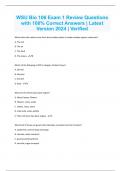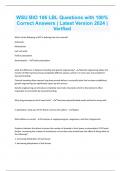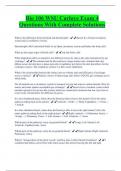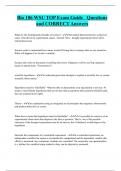Bio 106 wsu - Study guides, Class notes & Summaries
Looking for the best study guides, study notes and summaries about Bio 106 wsu? On this page you'll find 139 study documents about Bio 106 wsu.
Page 3 out of 139 results
Sort by

-
BIO 106 Exam 1 WSU Questions and Answers Rated A+
- Exam (elaborations) • 14 pages • 2024
- Available in package deal
-
- $9.99
- + learn more
BIO 106 Exam 1 WSU Questions and Answers Rated A+ Which of the following statements is most likely to be true? Water flows into the direction of the lowest water potential. Plasmolysis is a cellular loss of water. How can a cell potentially prevent this? Increasing the cytoplasmic solute concentration What is correct about stomata movement control? Pick the Best. Two of the above. Which tissue will an aphid quite specifically try to suck on? Phloem The water potential in the ...

-
Bio 106 WSU Carloye Exam #4 | Questions with 100% Correct Answers | Verified | Latest Update 2024
- Exam (elaborations) • 6 pages • 2024
- Available in package deal
-
- $7.99
- + learn more
What is the difference between blood and hemolymph? - Blood: In a Closed circulatory system and is confined to vessels. Hemolymph (AKA interstitial fluid): In an Open circulatory system and bathes the body cells. What are the major types of blood cells? - red and white cells What adaptations allow an animal to use diffusion across its skin as the only mechanism for gas exchange? - The animal must be thin and have a large surface area. Animals that only diffuse across the skin have a dense ...

-
WSU Bio 106 Exam 1 Review Questions with 100% Correct Answers | Latest Version 2024 | Verified
- Exam (elaborations) • 15 pages • 2024
- Available in package deal
-
- $12.49
- + learn more
WSU Bio 106 Exam 1 Review Questions with 100% Correct Answers | Latest Version 2024 | Verified

-
BIO 106 WSU Exam 1 Hellman Questions with 100% Correct Answers | Latest Version 2024 | Verified
- Exam (elaborations) • 8 pages • 2024
-
- $7.99
- + learn more
what are pneumatophores good for? - oxygen uptake what macronutrient helps with plant growth? - nitrogen deficiency of which mineral causes purplish coloration of the leaves? - phosphorus why can it be difficult for a plant to get access to cations in the soil? - clay is often negatively charged and tightly binds to cations which can make it difficult for the plant to take these ions up what protein causes a reddish color in plant tissue? - leghemoglobin what is leghemoglobin needed for in...

-
Bio 106 WSU Carloye Exam #4 | Questions with 100% Correct Answers | Verified | Latest Update 2024
- Exam (elaborations) • 6 pages • 2023
-
- $8.49
- + learn more
What is the difference between blood and hemolymph? - Blood: In a Closed circulatory system and is confined to vessels. Hemolymph (AKA interstitial fluid): In an Open circulatory system and bathes the body cells. What are the major types of blood cells? - red and white cells What adaptations allow an animal to use diffusion across its skin as the only mechanism for gas exchange? - The animal must be thin and have a large surface area. Animals that only diffuse across the skin have a dense ...

-
WSU BIO 106 LBL Questions with 100% Correct Answers | Latest Version 2024 | Verified
- Exam (elaborations) • 12 pages • 2024
- Available in package deal
-
- $11.49
- + learn more
WSU BIO 106 LBL Questions with 100% Correct Answers | Latest Version 2024 | Verified

-
Bio 106 WSU 2nd Exam Iclicker | Questions with 100% Correct Answers | Verified | Latest Update 2024
- Exam (elaborations) • 10 pages • 2023
-
- $12.49
- + learn more
Which of the following were probably factors that permitted early plants to successfully colonize land? 1. The limited number of potential predators (herbivores) 2. The limited number of competitors 3. The availability of symbiotic partners 4. The atmosphere's relative lack of support, compared to water. A) 1 and 2 B) 2 and 3 C) 3 and 4 D) 1, 2, and 3 E) 1, 2, and 4 - A) 1 and 2 1. The limited number of potential predators (herbivores) 2. The limited number of competitors Evidence i...
Bio 106 WSU Bundled Exam Questions Package with Correct Answers

-
Bio 106 WSU Carloye Exam 4 Questions With Complete Solutions
- Exam (elaborations) • 5 pages • 2024
- Available in package deal
-
- $7.99
- + learn more
Bio 106 WSU Carloye Exam 4 Questions With Complete Solutions What is the difference between blood and hemolymph? ️️Blood: In a Closed circulatory system and is confined to vessels. Hemolymph (AKA interstitial fluid): In an Open circulatory system and bathes the body cells. What are the major types of blood cells? ️️red and white cells What adaptations allow an animal to use diffusion across its skin as the only mechanism for gas exchange? ️️The animal must be thin and have ...

-
Bio 106 WSU Carloye Exam #4 | 2023 | 50 Questions with 100% Correct Answers | Updated & Verified
- Exam (elaborations) • 9 pages • 2023
- Available in package deal
-
- $11.49
- + learn more
What is the difference between blood and hemolymph? - Blood: In a Closed circulatory system and is confined to vessels. Hemolymph (AKA interstitial fluid): In an Open circulatory system and bathes the body cells. What are the major types of blood cells? - red and white cells What adaptations allow an animal to use diffusion across its skin as the only mechanism for gas exchange? - The animal must be thin and have a large surface area. Animals that only diffuse across the skin have a dense ...

Do you wonder why so many students wear nice clothes, have money to spare and enjoy tons of free time? Well, they sell on Stuvia! Imagine your study notes being downloaded a dozen times for $15 each. Every. Single. Day. Discover all about earning on Stuvia



